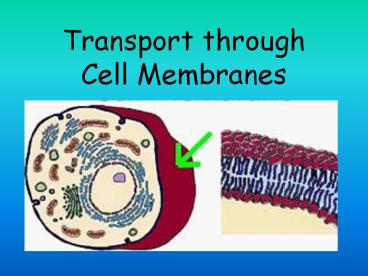Transport through Cell Membranes - PowerPoint PPT Presentation
1 / 44
Title:
Transport through Cell Membranes
Description:
Transport through Cell Membranes Transport through cell membranes The phospholipid bilayer is a good barrier around cells, especially to water soluble molecules. – PowerPoint PPT presentation
Number of Views:175
Avg rating:3.0/5.0
Title: Transport through Cell Membranes
1
Transport through Cell Membranes
2
Transport through cell membranes
- The phospholipid bilayer is a good barrier around
cells, especially to water soluble molecules.
However, for the cell to survive some materials
need to be able to enter and leave the cell. - There are 4 basic mechanisms
- DIFFUSION and FACILITATED DIFFUSION
- OSMOSIS
- ACTIVE TRANSPORT
- BULK TRANSPORT
3
Diffusion of Liquids
4
Diffusion is the net movement of molecules (or
ions) from a region of their high concentration
to a region of their lower concentration.The
molecules move down a concentration
gradient.As a result of diffusion molecules
reach an equilibrium where they are evenly spread
out, and there is no net movement of molecules
from either side.
5
DIFFUSION
Diffusion is a PASSIVE process which means no
energy is used to make the molecules move.
6
Diffusion through a membrane
Cell membrane
Outside cell
Inside cell
7
Diffusion through a membrane
Cell membrane
diffusion
Outside cell
Inside cell
8
Diffusion through a membrane
Cell membrane
Outside cell
Inside cell
EQUILIBRIUM
9
(No Transcript)
10
(No Transcript)
11
What determines the rate of diffusion?There 4
factors
- The steepness of the concentration gradient..
- Temperature.
- 3. The surface area.
- 4. The type of molecule or ion diffusing.
12
Molecules that diffuse through cell membranes
- Oxygen Non-polar so diffuses very quickly.
- Carbon dioxide Polar (small) so diffuses
quickly. - Water Polar (small) so diffuses quickly.
13
Osmosis
- The diffusion of water from an area of high
concentration of water molecules to an area of
low concentration of water across a partially
permeable membrane.
14
Osmosis
CONCENTRATED SOLUTION
DILUTE SOLUTION
Cell membrane partially permeable.
Sugar molecule
VERY Low conc. of water molecules. High water
potential.
VERY High conc. of water molecules. High water
potential.
Outside cell
Inside cell
15
Osmosis
Cell membrane partially permeable.
Low conc. of water molecules. High water
potential.
OSMOSIS
High conc. of water molecules. High water
potential.
Outside cell
Inside cell
16
Osmosis
Cell membrane partially permeable.
OSMOSIS
Outside cell
Inside cell
EQUILIBRIUM. Equal water concentration on each
side. Equal water potential has been reached.
There is no net movement of water
17
(No Transcript)
18
(No Transcript)
19
Direction of Osmosis
Water tends to flow from hypotonic to hypertonic
solutions
20
(No Transcript)
21
(No Transcript)
22
Actual Effects of Osmosis
23
(No Transcript)
24
Facilitated Diffusion
- Large polar molecules such as glucose and amino
acids, cannot diffuse across the phospholipid
bilayer. Also ions such as Na or Cl- cannot
pass. - These molecules pass through Carrier Proteins
instead. Diffusion through these channels is
called FACILITATED DIFFUSION. - Movement of molecules is still PASSIVE just like
ordinary diffusion, the only difference is, the
molecules go through a protein channel instead of
passing between the phospholipids.
25
Facilitated diffusion
26
(No Transcript)
27
Facilitated Diffusion through a membrane
Cell membrane
Protein channel
Outside cell
Inside cell
28
Facilitated Diffusion through a membrane
Cell membrane
diffusion
Protein channel
Outside cell
Inside cell
29
Facilitated Diffusion through a membrane
Cell membrane
diffusion
Protein channel
Outside cell
Inside cell
EQUILIBRIUM
30
Facilitated DiffusionMolecules will randomly
move through the opening like pore, by diffusion.
This requires no energy, it is a PASSIVE process.
Molecules move from an area of high
concentration to an area of low conc.
31
These are carrier proteins. They do not extend
through the membrane. They bond and drag
molecules through the bilipid layer and release
them on the opposite side.
32
(No Transcript)
33
(No Transcript)
34
ACTIVE TRANSPORT
- Requires input of energy
- Molecules moves against the concentration gradient
Sodium Potassium Pump
35
Active Transport
36
(No Transcript)
37
(No Transcript)
38
Bulk Transport
39
EXOCYTOSIS (Movement out of cell) Large
molecules that are manufactured in the cell are
released through the cell membrane.
40
Vesicle-Mediated Transport Vesicles and
vacuoles that fuse with the cell membrane may be
utilized to release or transport chemicals out of
the cell or to allow them to enter a cell.
Exocytosis is the term applied when transport is
out of the cell.
41
ENDOCYTOSIS is the case when a molecule causes
the cell membrane to bulge inward, forming a
vesicle. PHAGOCYTOSIS is the type of
endocytosis where an entire cell is engulfed.
cell eatingPINOCYTOSIS is when the external
fluid is engulfed. cell drinking Examples
include the transport of insulin and cholesterol
into animal cells.
42
Cell Membrane - Function - Endocytosis In this
process the membrane itself wraps around the
particle and pinches off a vesicle inside the
cell. In this animation an ameba engulfs a food
particle.
43
(No Transcript)
44
THE END































